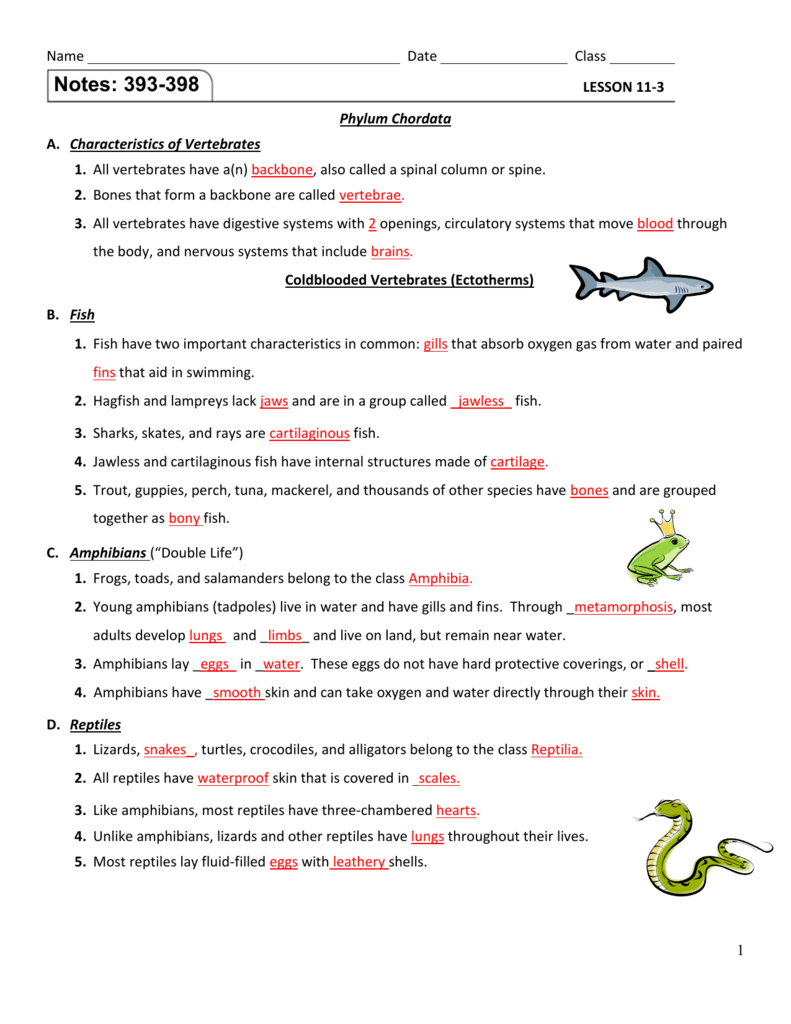Chordates Fishes And Amphibian Study Guide
Subphylum: Vertebrata class: Agnatha Chondrichthyes Osteichthyes Amphibia Reptilia Aves Mammalia Three of the vertebrate classes are fish. The most primitive of these is Agnatha.
- Chordates Fishes And Amphibian Study Guide Answer Key
- Chordates Fishes And Amphibian Study Guide Answers
It consists of jawless fish that do not have scale s. These are the lampreys and hagfish. Fish that have skeletons consisting of hard rubber-like cartilage rather than bone are members of the class Chondrichthyes. These are the sharks and rays. All of the bony fish are members of the class Osteichthyes.

The vertebrates are distinguished by the presence of a backbone, and are the organisms that come to mind when one thinks of an animal: fish, amphibians,. Vertebrate Class Representative Animals Heart Skeletal Material Other. Mammals probably evolved from a. A type of fish. Dog-like carnivores. Members of the phylum Chordata all have a. Start studying Phylum Chordata: Fishes and Amphibians. Learn vocabulary, terms, and more with flashcards, games, and other study tools.
Tuna, bass, salmon, and trout are examples of Osteichthyes. Salamander and frog (class Amphibia) The class Reptilia includes turtles, snakes, lizards, alligators, and other large reptiles. All of them have lungs to breathe on land and skin that does not need to be kept wet. They produce an amniote egg which usually has a calcium carbonate rich, leather hard shell that protects the embryo from drying out. This is an advantage over fish and amphibians because the amniote egg can be laid on land where it is usually safer from predators than it would be in lakes, rivers, and oceans. Tortoise, snake, and lizard (class Reptilia) Amniote egg The class Aves includes all the birds.
They also produce amniote eggs but usually give them greater protection from predators by laying them high off of the ground or in other relatively inaccessible locations. In the case of both reptiles and birds, the eggs are fertilized within the reproductive tract of females.
Chordates Fishes And Amphibian Study Guide Answer Key
There are other striking similarities between reptiles and birds in their anatomies and reproductive systems. This is not surprising because birds are descendents of theropod dinosaurs (two-legged mostly carnivorous dinosaurs).
Birds (class Aves) Dogs, cats, bears, humans and most other large animals today are members of the vertebrate class Mammalia. All mammals conceive their young within the reproductive tract of the mother and, after birth, nourish them with milk produced by their. Mammals are heterodonts with strong jaws. That is to say, they have a variety of specialized teeth (incisors, canines, premolars, and molars).
This allows them to chew their food into small pieces before swallowing it. Subsequently, they can eat any size plant or animal. Many reptiles must swallow their prey whole, which limits them to hunting smaller game. Mammalian heterodontism Like birds, mammals are endothermic, or warm blooded. They are able to maintain a relatively constant body temperature regardless of external environmental conditions mainly by using internal physiological mechanisms.
In other words, they are homeothermic, or stable in core body temperature, as a result of endothermy. All of the living species of insects, fish, reptiles, and amphibians are ectothermic, or cold blooded. They keep their body temperature in a normal range mainly by avoiding exposure to environmental temperature extremes. For instance, reptiles usually remain in shaded areas on hot days to prevent fatal overheating. On cold nights, their lowered body temperature can cause them to become sluggish and inactive. In contrast, endothermic animals are able to remain active at night and often in the winter when the air temperatures are especially cold.
They can also move about in the heat of very warm days. This ability most likely provided an advantage for the early small mammals in surviving alongside dinosaurs and other large reptiles, which apparently were mostly ectothermic. The downside of endothermy is the need to consume far more calories relative to body size in order to maintain a constant core body temperature. Small mammals, such as moles with their rapid metabolism rates, must eat insects or other high calorie foods every half hour or so in order to stay alive. By comparison, cold blooded rattlesnakes usually eat only once every 3-6 weeks and have been known to go without food for as long as two years. Aiding in mammal body temperature control is their insulating hair and sweat glands. Sweating helps to dissipate heat by evaporative cooling.
Compared to most other land mammals, humans are relatively hairless, but they have far more sweat glands. Mammals have four chambered hearts (like birds), complex nervous systems, and large brains relative to the size of their bodies. This broad range of useful features has made mammals highly adaptive and successful. They first appeared about 200,000,000 years ago, early in the age of dinosaurs, and replaced reptiles as the dominant class of land animals after 65,000,000 years ago. As the rapidly changing environment at that time led to the mass extinction of most large reptiles, it left vast evolutionary possibilities which mammals took advantage of by rapidly diversifying through adaptive radiation. Important to mammalian success is their reproductive system. Their bodies took the revolution of reptiles and birds one step further.

In effect, the uterus functions as the protective eggshell. Young mammals spend a long period of their early development within their mother's uterus. After birth, they are provided with protein and fat rich milk to eat and are usually protected until maturity.
Chordates Fishes And Amphibian Study Guide Answers
Pregnancy and milk production require mothers to significantly increase their own calorie consumption in order to provide nutrients for their infant s. A nursing human female normally uses about 30% of her body's energy just to produce milk.
